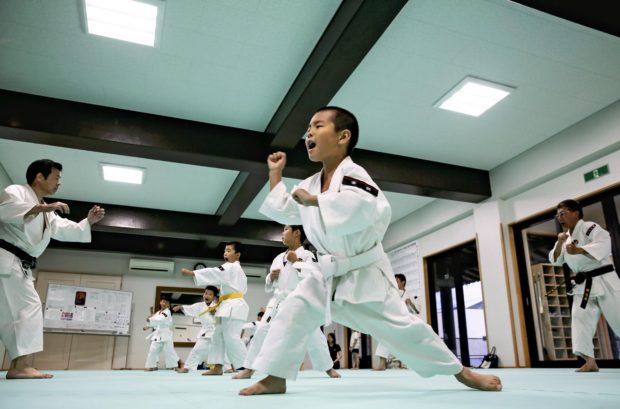
TADOTSU, Kagawa — Amid sweltering heat one late July afternoon — at one point the mercury reached 35.2 C — spirited cries of “Aah” and “Sei” echoed through the doin training center of the Shorinji kempo headquarters in Tadotsu, Kagawa Prefecture. About 30 men and women wearing white uniforms and aged from 4 to 75 welcomed the reporter with their hands joined in front of their chests.
Movies may lead some people to confuse Shorinji kempo with the Chinese traditional martial art of Shaolin kung fu. Shorinji kempo is a Japan-born martial art created in 1947 in Tadotsu, a revered spot for Shorinji kempo practitioners.
The founder of Shorinji kempo was the late Doshin So (1911-1980), a martial artist, educator and religious figure. So learned martial arts in Manchuria (currently northeastern China) before the end of World War II. He studied various martial arts after the war and created Shorinji kempo on his own at the practice hall of his home in Tadotsu.
In the chaos of the postwar period, So’s teachings about “developing as a human being” resonated with young people who were feeling hopeless, and Shorinji kempo spread far and wide. It is said that currently there are about 2,800 training halls across the nation, and 1.8 million practitioners in Japan and at overseas branches at 39 countries in North America, Europe and Asia.
So once saw a mural portraying monks training in martial arts at the Songshan Shaolin Temple in what is now Henan Province, China. He was very impressed by the mural, which led to his choosing the name Shorinji kempo. Shaolin Temple is read as “shorinji” in Japanese.
Shorinji kempo emphasizes defense. There are a number of offensive moves such as punches and kicks, but Shorinji kempo is dominated by throwing moves to dodge and utilize the opponent’s offensive power. There are said to be more than 600 moves, including combination moves, in Shorinji kempo.
“It is not enough to just acquire techniques or doctrines,” said Toshiyuki Mukai. “Once you train your soul and body together, you can enhance yourself.”
At 75, Mukai is the oldest person training at the headquarters’ training hall. “I find new aspects even though I have practiced for so many years. [Shorinji kempo] is profound. What it teaches us certainly indicates the good character of the founder,” he said.
Originally from Marugame, an eastern neighbor of Tadotsu, Mukai started Shorinji kempo after he entered college in Tokyo. Once a year, Mukai visited home and practiced at the headquarters. The founder used to speak kindly to Mukai, asking things like: “How is your practice coming?”
So sat in a circle with practitioners and ardently told them about the places he visited during his Manchuria days and the important things in learning martial arts. He often told them, “Be a leader who can lead other people.”
“[So] treated everybody equally, and frankly,” Muraki recalled. “I was fascinated by the aura he had.”
Under revised teaching guidelines, martial arts became mandatory at junior high schools in fiscal 2012 and Shorinji kempo was included as one option. In fiscal 2014, it became an official event of the Inter-High School Championships.
In the Inter-High School Championships and competition organized by the Japanese Shorinji Kempo Federation, there are three categories of “embu” demonstrations for men and women, conducted in groups of six and eight, in pairs and alone. Participants are awarded points for “technique” based on how precise their moves are, and for “expression,” such as how well they show their fighting spirit and other elements.
Kodai Yamaji, a third-year high school student who belongs to the headquarters’ practice hall, was unable to win the title at the latest Inter-High School Championships in June. Fueled by strong regret, the 17-year-old trained hard and won a prefectural tournament in July.
“[Shorinji kempo] emphasizes manners, and I can improve my mental condition while brushing up my moves,” Yamaji smiled. “I made many friends and learned perseverance.”
Yamaji will soon be busy studying to get into college. However, he wants to continue Shorinji kempo after going to university and entering the workforce.
Shorinji kempo instructors across the nation train themselves at the Kongo Zen Sohonzan Shorinji temple in Tadotsu. The town also has a correspondence high school that uses Shorinji kempo in classes. The martial art born in this town has taken deep root here, 71 years after its foundation.
■Access
It takes about two hours from Okayama Station to Tadotsu Station by “Shiokaze” or “Nanpu” express service. It is about 500 meters from Tadotsu Station to the headquarters’ training center. A memorial hall converted from So’s home is nearby, and a small tatami mat room where So taught Shorinji kempo to young people can be seen in a tour.
About 500 meters further to the southwest is Shorinji temple, where the Shorinji kempo headquarters are located. The Niomon deva gate and red building are impressive. For information, call the temple at (0877) 33-1010 to tour the memorial hall.









































